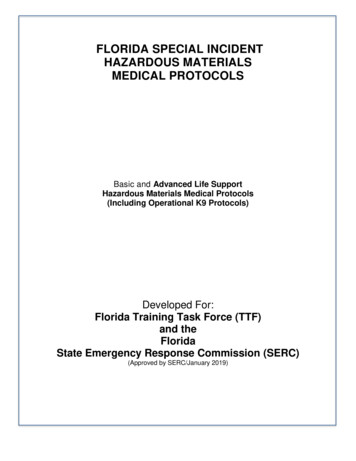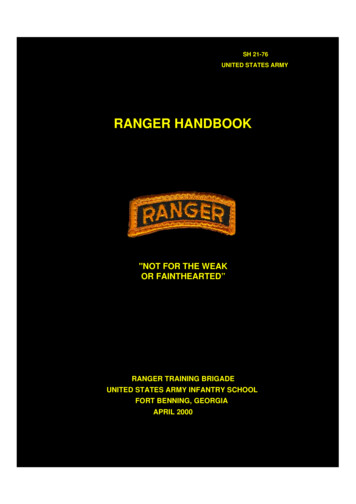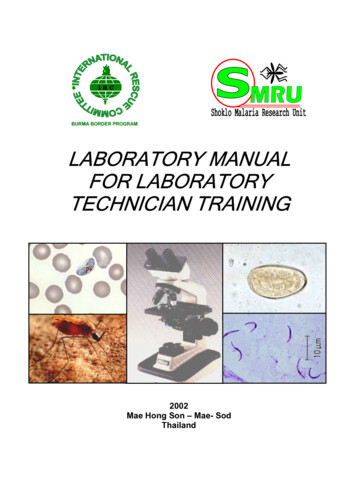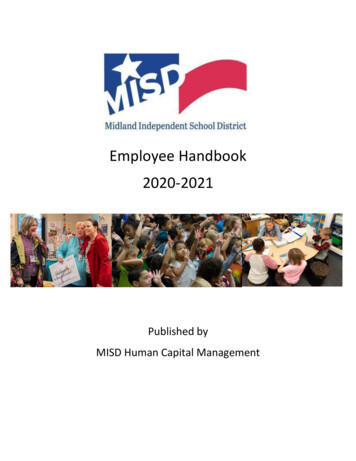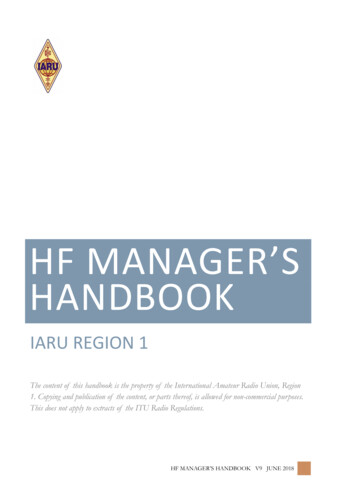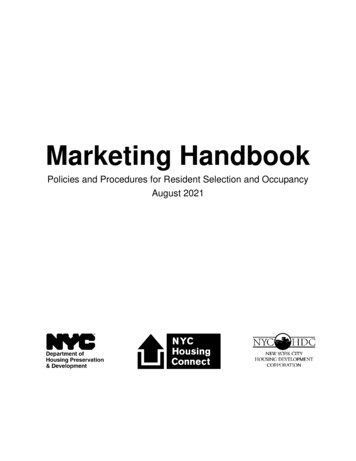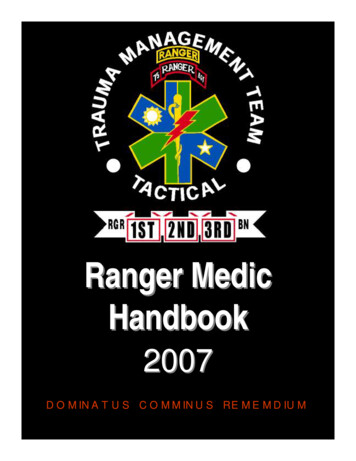
Transcription
Ranger MedicHandbook2007DOMINATUS COMMINUS REMEMDIUM
75th Ranger Regiment Trauma Management Team (Tactical)Ranger Medic HandbookIn Memoriam to Our FallenRanger Medic Comrades SFC Marcus V. MurallesKIA – 28 June 2005 – AfghanistanOperation: Enduring FreedomSpecial Operations Flight Medic 2003-2005HHC, 3/160th Special Operations Aviation RegimentCompany Senior Medic and Platoon Medic 1999-2003B Co, 3rd Battalion, 75th Ranger RegimentCompany Senior Medic and Platoon Medic 1990-1993C Co, 3rd Battalion, 75th Ranger RegimentPFC James M. MarkwellKIA – 20 December 1989 – PanamaOperation: Just CausePlatoon Medic 1989C Co, 1 Battalion, 75th Ranger Regimentst and one for the Airborne Ranger in the Sky.
75th Ranger Regiment Trauma Management Team (Tactical)Ranger Medic HandbookFORWARDHistorically in warfare, the majority of all combat deaths have occurred prior to acasualty ever receiving advanced trauma management. The execution of the Rangermission profile in the Global War on Terrorism and our legacy tasks undoubtedly willincrease the number of lethal wounds.Ranger leaders can significantly reduce the number of Rangers who die ofwounds sustained in combat by simply targeting optimal medical capability in closeproximity to the point of wounding. Survivability of the traumatized Ranger who sustainsa wound in combat is in the hands of the first responding Ranger who puts a pressuredressing or tourniquet and controls the bleeding of his fallen comrade. Directingcasualty response management and evacuation is a Ranger leader task; ensuringtechnical medical competence is a Ranger Medic task.A solid foundation has been built for Ranger leaders and medics to be successfulin managing casualties in a combat environment. An integrated team response fromnon-medical personnel and medical providers must be in place to care for the woundedRanger. The Ranger First Responder, Squad EMT, Ranger Medic Advanced TacticalPractitioner, and Ranger leaders, in essence all Rangers must unite to provide medicalcare collectively, as a team, without sacrificing the flow and violence of the battle athand.An integrated team approach to casualty response and care will directly translateto the reduction of the died of wounds rate of combat casualties and minimize theturbulence associated with these events in times of crisis. The true success of theRanger Medical Team will be defined by its ability to complete the mission and greatlyreduce preventable combat death. Rangers value honor and reputation more than theirlives, and as such will attempt to lay down their own lives in defense of their comrades.The Ranger Medic will do no less.I will never leave a fallen comrade Harold R. MontgomeryRuss S. Kotwal, MDMSG, USARegimental Senior Medic1997-PresentLTC, MCRegimental Surgeon2005-PresentRHHC Senior Medic1995-19971/75 Plt, Co, BAS NCOIC1990-19953/75 Battalion Surgeon1999-2003Ranger Medic Handbook 2007 Edition75th Ranger Regiment, US Army Special Operations Command
75th Ranger Regiment Trauma Management Team (Tactical)Ranger Medic HandbookTable of ContentsSubjectPageSECTION ONERMED Mission Statement ------------ 1-1RMED Charter --------------------------- 1-2Review Committees --------------------- 1-3Editorial Consultants & Contributors -------------------------------------------------- 1-4Key References -------------------------- 1-5RMED Scope of Practice -------------- 1-6RMED Standing Orders & Protocol Guidelines ------------------------------------ 1-8Casualty Assessment & Management ----------------------------------------------- 1-10Tactical Combat Casualty Care (TCCC) --------------------------------------------- 1-17SECTION TWOTactical Trauma Assessment ------ 2-1Medical Patient Assessment Protocol ------------------------------------------------ 2-2Airway Management Protocol -------- 2-3Surgical Cricothyroidotomy Procedure -------------------------------------- 2-4King-LT D Supralaryngeal Airway Insertion Procedure ----------------- 2-5Orotracheal Intubation Procedure -------------------------------------------- 2-6Hemorrhage Management Procedure ------------------------------------------------ 2-7Tourniquet Application Procedure -------------------------------------------- 2-8Hemostatic Agent Application Protocol -------------------------------------- 2-9Tourniquet Conversion Procedure -------------------------------------------- 2-10Thoracic Trauma Management Procedure ------------------------------------------ 2-11Needle Chest Decompression Procedure ---------------------------------- 2-12Chest Tube Insertion Procedure ---------------------------------------------- 2-13Hypovolemic Shock Management Protocol ----------------------------------------- 2-14Saline Lock & Intravenous Access Procedure ----------------------------- 2-15External Jugular Intravenous Cannulation Procedure ------------------- 2-16Sternal Intraosseous Infusion Procedure ----------------------------------- 2-17Hypothermia Prevention & Management Kit Procedure ---------------- 2-18Head Injury Management Protocol -- 2-19Mild Traumatic Brain Injury (Concussion) Management Protocol ------------- 2-20Seizure Management Protocol ------- 2-21Spinal Cord Injury Management Protocol -------------------------------------------- 2-22Orthopedic Trauma Management Protocol ------------------------------------------ 2-23Burn Management Protocol ----------- 2-24Foley Catheterization Procedure --------------------------------------------- 2-25Pain Management Protocol ----------- 2-26Anaphylactic Shock Management Protocol ----------------------------------------- 2-27Ranger Medic Handbook 2007 Edition75th Ranger Regiment, US Army Special Operations Command
75th Ranger Regiment Trauma Management Team (Tactical)Ranger Medic HandbookSubjectPageSECTION TWO ContinuedHyperthermia (Heat) Management Protocol ---------------------------------------- 2-28Hypothermia Prevention & Management Protocol -------------------------------- 2-29Behavioral Emergency Management Protocol ------------------------------------- 2-30Altitude Medical Emergency Management Protocol ------------------------------ 2-31Acute (Surgical) Abdomen ------------ 2-33Acute Dental Pain ----------------------- 2-33Acute Musculoskeletal Back Pain --- 2-33Allergic Rhinitis --------------------------- 2-34Asthma (Reactive Airway Disease) - 2-34Bronchitis ---------------------------------- 2-34Cellulitis ------------------------------------ 2-35Chest Pain (Cardiac Origin Suspected) ---------------------------------------------- 2-35Common Cold ---------------------------- 2-35Conjunctivitis ------------------------------ 2-36Constipation ------------------------------- 2-36Contact Dermatitis ----------------------- 2-36Corneal Abrasion & Corneal Ulcer -- 2-37Cough --------------------------------------- 2-37Cutaneous Abscess --------------------- 2-37Deep Venous Thrombosis (DVT) ---- 2-38Diarrhea ------------------------------------ 2-38Epiglottitis ---------------------------------- 2-38Epistaxis ------------------------------------ 2-39Fungal Skin Infection -------------------- 2-39Gastroenteritis ---------------------------- 2-39Gastroesophageal Reflux Disease (GERD) ----------------------------------------- 2-40Headache ---------------------------------- 2-40Ingrown Toenail -------------------------- 2-40Joint Infection ----------------------------- 2-41Laceration --------------------------------- 2-41Malaria ------------------------------------- 2-41Otitis Externa ----------------------------- 2-42Otitis Media ------------------------------- 2-42Peritonsillar Abscess ------------------- 2-42Pneumonia -------------------------------- 2-43Pulmonary Embolus (PE) -------------- 2-43Renal Colic -------------------------------- 2-43Sepsis / Septic Shock ------------------ 2-44Smoke Inhalation ------------------------ 2-44Sprains & Strains ------------------------ 2-44Subungal Hematoma ------------------- 2-45Syncope ------------------------------------ 2-45Testicular Pain ---------------------------- 2-45Tonsillopharyngitis ----------------------- 2-46Urinary Tract Infection (UTI) -----------2-46Ranger Medic Handbook 2007 Edition75th Ranger Regiment, US Army Special Operations Command
75th Ranger Regiment Trauma Management Team (Tactical)Ranger Medic HandbookSubjectPageSECTION THREEPharmacology Section I: “Proficient and Always Carried” ----------------------- 3-1Pharmacology Section II: “Proficient” ------------------------------------------------- 3-11Pharmacology Section III: “Familiar” -------------------------------------------------- 3-26SECTION FOURRMED Duties & Responsibilities ---- 4-1Medical & Casualty Response Planning --------------------------------------------- 4-2Initial Planning / WARNORD - 4-2Tactical Operation Development ---------------------------------------------- 4-3Coordination & Synchronization ----------------------------------------------- 4-6Briefs, Rehearsals, and Inspections ------------------------------------------ 4-6After Action Review in Training or Combat --------------------------------- 4-7Casualty Collection Point (CCP) Operations --------------------------------------- 4-8CCP Duties & Responsibilities ------------------------------------------------- 4-8Casualty Response Rehearsals ----------------------------------------------- 4-9CCP Site Selection ------------- 4-9CCP Operational Guidelines - 4-10CCP Building Guidelines ------ 4-10Evacuation Guidelines --------- 4-11CCP Layout Templates -------- 4-11General Guidelines for CCP Personnel ------------------------------------- 4-14Casualty Marking & Tagging - 4-14MEDEVAC Request Format ---------- 4-16Hazardous Training Medical Coverage ---------------------------------------------- 4-17Pre-Deployment & RRF-1 Assumption Procedures ------------------------------ 4-22Post-Deployment & Recovery Procedures ----------------------------------------- 4-24SECTION FIVERMED Packing Lists -------------------- 5-1RMED RBA/RLCS Minimum Packing List ---------------------------------- 5-1RMED Assault Aid-Bag Minimum Packing List ---------------------------- 5-2RMED Medications Kit Minimum Packing List ----------------------------- 5-3Combat Wound Pill Pack (CWPP) Stockage List ------------------------- 5-3Saline Lock Kit Stockage List -------------------------------------------------- 5-4Chest Tube Kit Stockage List -------------------------------------------------- 5-4Cricothyroidotomy Kit Stockage List ----------------------------------------- 5-4IV Kit Stockage List ------------- 5-4Minor Wound Care Kit Stockage List ---------------------------------------- 5-5Abbreviation List ------------------------- 5-6Conversion Charts ----------------------- 5-10The Ranger Medic Code --------------- 5-11The Ranger Creed ----------------------- 5-12Ranger Medic Handbook 2007 Edition75th Ranger Regiment, US Army Special Operations Command
75th Ranger Regiment Trauma Management Team (Tactical)Ranger Medic HandbookSECTION ONEGENERALOVERVIEWRanger Medic Handbook 2007 Edition75th Ranger Regiment, US Army Special Operations Command
75th Ranger Regiment Trauma Management Team (Tactical)Ranger Medic HandbookMISSION STATEMENTThe mission of the 75th Ranger Regiment TraumaManagement Team (Tactical) is to provide medicalcare and training in accordance with the tenets ofTactical Combat Casualty Care, Tactical MedicalEmergency Protocols, and Pre-Hospital Trauma LifeSupport; in order to provide optimal health care to aJoint Special Operations Task Force conductingmissions in support of U.S. policies and objectives.Ranger Medic Handbook 2007 Edition1-175th Ranger Regiment, US Army Special Operations Command
75th Ranger Regiment Trauma Management Team (Tactical)Ranger Medic HandbookRANGER MEDIC CHARTER“SOCM ATP”(Special Operations Combat MedicAdvanced Tactical Practitioner)Shoot and engage targets to defend casualties and self.Operaterelatively independently with highly-dispersedhighly-mobile combat formations in an austereenvironment.Communicate via secure and non-secure means.Move tactically through unsecured areas.Absolutemaster of the basics through pre-hospitaltrauma life support and tactical combat casualty care.Timely, consistent, and competent provider of advancedtrauma management within scope of practice.Practitioner who assists licensed medical providers withmedical emergencies and routine care encounteredwhile in garrison, training, and during deployments.1-2Ranger Medic Handbook 2007 Edition75th Ranger Regiment, US Army Special Operations Command
75th Ranger Regiment Trauma Management Team (Tactical)Ranger Medic HandbookREVIEW COMMITTEES2001MAJ Kotwal (3/75 Battalion Surgeon)MAJ Meyer (3/75 Battalion PT)CPT Detro (3/75 Battalion PA)SFC Miller (3/75 Battalion Senior Medic)SFC Montgomery (Regimental Senior Medic)SSG Flores (3/75 Company Senior Medic)SSG Gentry (3/75 Company Senior Medic)SSG Muralles (3/75 Company Senior Medic)SSG Odom (3/75 Company Senior Medic)SSG Rothwell (3/75 Company Senior Medic)2003MAJ Wenzel (Regimental Surgeon)MAJ Cain (1/75 Battalion Surgeon)MAJ Kotwal (3/75 Battalion Surgeon)MAJ Sassano (Regt Med Ops Officer)SFC Montgomery (Regimental Senior Medic)SFC Miller (Regt Med Plans & Trng NCO)SFC Swain (2/75 Battalion Senior Medic)SFC Flores (3/75 Battalion Senior Medic)SSG Odom (3/75 Senior Medic)SSG Williamson (2/75 Company Sr Medic)2004MAJ Wenzel (Regimental Surgeon)CPT Pairmore (1/75 Battalion PA)CPT Nieman (2/75 Battalion PA)CPT Kelsey (Regt Med Ops Officer)MSG Montgomery (Regt Senior Medic)SFC Crays (2/75 Battalion Senior Medic)SFC Flores (3/75 Battalion Senior Medic)SSG Odom (3/75 Battalion Senior Medic)SSG Williamson (Regt Med Training NCO)SSG Medaris (1/75 Company Senior Medic)SSG Garcia (2/75 Company Senior Medic)SSG Severtson (2/75 Company Sr Medic)1-32005LTC Kotwal (Regimental Surgeon)MAJ Matthews (1/75 Battalion Surgeon)MAJ McCarver (2/75 Battalion Surgeon)CPT Sterling (Regimental PA)CPT Detro (3/75 Battalion PA)CPT Reedy (1/75 Battalion PA)CPT Slevin (2/75 Battalion PA)CPT Grenier (2/75 Battalion PT)CPT Soliz (3/160 Battalion PA)MSG Montgomery (Regimental Senior Medic)SFC Crays (2/75 Battalion Senior Medic)SFC Warren (1/75 Battalion Senior Medic)SSG Williamson (Regt Med Plans & Tng NCO)SSG Gillaspie (2/75 Company Senior Medic)SGT Kindig (2/75 Company Senior Medic)SGT Robbins (3/75 Company Senior Medic)SGT Slavens (3/75 Company Senior Medic)SGT Morissette (3/75 Platoon Medic)SPC Kacoroski (2/75 Platoon Medic)SPC Ball (2/75 Platoon Medic)SPC Lewis (3/75 Platoon Medic)SPC Guadagnino (3/75 Platoon Medic)SPC Drapeau (3/75 Platoon Medic)2006LTC Kotwal (Regimental Surgeon)CPT Redman (1/75 Battalion Surgeon)CPT Cunningham (2/75 Battalion Surgeon)CPT Miles (3/75 Battalion Surgeon)CPT Sterling (Regimental PA)CPT Detro (Regimental PA)CPT Fox (3/75 Battalion PA)CPT Speer (Regt Med Ops Officer)CPT Pollman (3/75 Battalion PT)MSG Montgomery (Regimental Senior Medic)SFC Odom (Regimental Medical Training NCO)SSG Veliz (ROC Senior Medic)SSG Garcia (2/75 Battalion Senior Medic)SSG Williamson (3/75 Battalion Senior Medic)SSG Gillaspie (2/75 Company Senior Medic)SSG Bernas (2/75 Company Senior Medic)SSG Chavaree (3/75 Company Senior Medic)SSG Henigsmith (3/75 Company Senior Medic)SGT Maitha (3/75 Company Senior Medic)Ranger Medic Handbook 2007 Edition75th Ranger Regiment, US Army Special Operations Command
75th Ranger Regiment Trauma Management Team (Tactical)Ranger Medic HandbookEDITORIAL CONSULTANTSExecutive Standing Members:CAPT (Ret) Frank Butler, MDCW4 (Ret) William Donovan, PA-CCOL John Holcomb, MDLTC Russ Kotwal, MD, MPHSFC (Ret) Robert Miller, NREMTMSG Harold Montgomery, NREMTJeffrey Salomone, MDConsulting & Contributing Members:LTC Bret Ackermann, DOMSG Perry Black, NREMTCPT (Ret) Gregory Bromund, PA-CLTC Brian Burlingame, MDMAJ Jeffrey Cain, MDCPT John Detro, PA-CMAJ Arthur Finch, PhDJ.F. Rick Hammesfahr, MDMAJ Shawn Kane, MDMSG(Ret) Cory Lamoreaux, NREMTLTC Robert Lutz, MDMAJ Clinton Murray, MDCPT (Ret) David Nieman, PA-CLTC Kevin O’Connor, DOCPT James Pairmore, PA-CMAJ John Rayfield, MDCPT Raymond Sterling, PA-CRepresentative Organizations:Committee on Tactical Combat Casualty CareDefense and Veterans Brain Injury CenterEmory University Department of Surgery, Atlanta, GAGrady Memorial Hospital, Atlanta, GAJoint Special Operations Medical Training CenterPHTLS Committee of the NAEMTUS Army Institute of Surgical ResearchUS Special Operations Command State Department of EMS and Public Health2007 Edition Chief Editors:LTC Russ Kotwal, MD, MPHMSG Harold Montgomery, NREMT, SOF-ATP1-4Ranger Medic Handbook 2007 Edition75th Ranger Regiment, US Army Special Operations Command
75th Ranger Regiment Trauma Management Team (Tactical)Ranger Medic HandbookKEY REFERENCESTexts:1. Advanced Trauma Life Support for Doctors. 7th Edition, American College ofSurgeons, Mosby, 2004.2. Basic and Advanced Prehospital Trauma Life Support: Military Edition. Revised5th Edition, National Association of Emergency Medical Technicians, Mosby, 2004.3. Emergency Medicine: A Comprehensive Study Guide. 6th Edition, AmericanCollege of Emergency Physicians, McGraw-Hill, 2004.4. Emergency War Surgery. 3rd US Revision, Borden Institute, 2004.5. Griffith’s Five-Minute Clinical Consult. Lippincott, 2006.6. Guidelines for Field Management of Combat-Related Head Trauma. BrainTrauma Foundation, 2005.7. Prentice Hall Nurse’s Drug Guide. Wilson, Shannon, and Stang, 2007.8. Tactical Medical Emergency Protocols for Special Operations AdvancedTactical Practitioners (ATPs). US Special Operations Command, 2006.9. Tarascon Adult Emergency Pocketbook. 3rd Edition, Tarascon, 2005.10. Tarascon Pocket Pharmacopoeia. Tarascon, 2006.11. The Sanford Guide to Antimicrobial Therapy. 35th Edition, Antimicrobial Therapy,2005.12. Wilderness Medicine. 4th Edition, Mosby, 2001.Articles:1. Bellamy RF. The causes of death in conventional land warfare: implications forcombat casualty care research. Military Medicine, 149:55, 1984.2. Butler FK, Hagmann J, Butler EG. Tactical Combat Casualty Care in SpecialOperations. Military Medicine, 161(3 Suppl):1-15, 1996.3. Butler FK Jr, Hagmann JH, Richards DT. Tactical management of urban warfarecasualties in special operations. Military Medicine, 165(4 Suppl):1-48, 2000.4. Holcomb JB. Fluid resuscitation in modern Combat Casualty Care: lessonslearned from Somalia. Journal of Trauma, 54(5):46, 2003.5. Kotwal RS, O’Connor KC, Johnson TR, Mosely DS, Meyer DE, Holcomb JB. Anovel pain management strategy for Combat Casualty Care. Annals ofEmergency Medicine, 44(2):121-7, 2004.6. Lind GH, Marcus MA, Mears SL, et al. Oral transmucosal fentanyl citrate foranalgesia and sedation in the emergency department. Annals of EmergencyMedicine, 20(10):1117-20, 1991.7. Murray CK, Hospenthal DR, Holcomb JB. Antibiotic use and selection at the pointof injury in Tactical Combat Casualty Care for casualties with penetratingabdominal injury, shock, or inability to tolerate oral agents. Journal of SpecialOperations Medicine, 3(5):56-61, 2005.8. O’Connor KC, Butler FK. Antibiotics in Tactical Combat Casualty Care. MilitaryMedicine, 168:911-4, 2003.1-5Ranger Medic Handbook 2007 Edition75th Ranger Regiment, US Army Special Operations Command
75th Ranger Regiment Trauma Management Team (Tactical)Ranger Medic HandbookSCOPE OF PRACTICERANGER FIRST RESPONDER (RFR) – A Ranger who has successfully completed theRanger First Responder Course. RFRs conduct their scope of practice under thelicense of a medical director. Every Ranger is to be RFR qualified.THE 8 “CRITICAL” RFR TASKS:1)Contain Scene and Assess Casualtiesooooo2)Return Fire and Secure SceneDirect Casualties to CoverEvaluate for Life Threatening InjuriesTriage – Immediate, Delayed, Minimal, ExpectantCall Medical Personnel for Assistance as RequiredRapidly Identify and Control Massive Hemorrhageo Direct & Indirect Pressureo Tourniqueto Emergency Trauma Dressing3) Inspect and Ensure Patent Airwayo Open and Clear Airwayo Nasopharyngeal Airway4)Treat Life Threatening Torso Injurieso Occlusive Seal Dressingo Needle Decompressiono Abdominal wound management5) Inspect for Bleeding, Gain IV Access, Manage Shocko Head to Toe Blood Sweepso 18 Gauge Saline Locko IV Fluids when dictated by Shocko Prevent Hypothermia6)Control Pain and Prevent Infectiono Combat Wound Pill Pack7)Aid and Litter Teamo Package and Prepare for Transfero SKEDCO, Litters, Manual Carries8)Leader Coordinated Evacuationo Casualty Precedence – Critical (Urgent), Priority, Routineo CASEVAC or MEDEVAC Coordination1-6Ranger Medic Handbook 2007 Edition75th Ranger Regiment, US Army Special Operations Command
75th Ranger Regiment Trauma Management Team (Tactical)Ranger Medic HandbookSQUAD EMT – A non-medical MOS Ranger currently registered as an EMTBasic/Intermediate by the Department of Transportation (DOT) and designated by thecommand to operate in this capacity. This individual functions as a bridge between theRFR and the Ranger Medic in respect to tactical and administrative traumamanagement. Squad EMTs conduct their scope of practice under the licensure of amedical director.SPECIAL OPERATIONS COMBAT MEDIC ADVANCED TACTICAL PRACTITIONER(SOCM-ATP) – A Ranger Medic currently registered as an NREMT-Paramedic by theDOT and/or USSOCOM State-Paramedic (Advanced Tactical Practitioner) who hasbeen awarded the identifier W1 (Special Operations Combat Medic) and has beenapproved by the unit Medical Director to function at this advanced level of care. ARanger Medic can train and direct routine and emergency medical care, establishcombat casualty collection points, conduct initial surgical and medical patientassessment and management, triage and provide advanced trauma management, andprepare patients for evacuation.Routine garrison care includes assisting unit medical officers with daily sick call andrequires advanced knowledge in common orthopedic problems, respiratory illnesses,gastrointestinal disorders, dermatological conditions, and environmental hazardillnesses. Ranger Medics train non-medical personnel on first responder skills andpreventive medicine. Ranger Medics conduct their scope of practice under the licensureof a medical director and are not independent health care providers. Ranger Medicsshould always obtain medical director advice and supervision for all care provided.However, on rare occasions Ranger Medics may be required to operate relativelyindependently with only indirect supervision in remote, austere, or clandestine locations.In these cases, it is still extremely rare that a Ranger Medic will be unable tocommunicate by radio, phone, or computer.STANDING ORDERS – Advanced life support interventions, which may be undertakenbefore contacting on-line medical control.PROTOCOLS – Guidelines for out of hospital patient care. Only the portions of theguidelines, which are designated as “standing orders”, may be undertaken beforecontacting an on-line medical director.MEDICAL CONTROL / MEDICAL DIRECTOR / MEDICAL OFFICER – A licensed andcredentialed medical provider, physician or physician assistant, who verbally, or inwriting, states assumption of responsibility and liability and is available on-site or can becontacted through established communications. Medical care, procedures, andadvanced life-saving activities will be routed through medical control in order to provideoptimal care to all sick or injured Rangers. Medical Control will always be established,regardless of whether the scenario is a combat mission, a training exercise, or routinemedical care. Note that, ultimately, all medical care is conducted under thelicensure of an assigned, attached, augmenting, or collocated physician.1-7Ranger Medic Handbook 2007 Edition75th Ranger Regiment, US Army Special Operations Command
75th Ranger Regiment Trauma Management Team (Tactical)Ranger Medic HandbookSTANDING ORDERS AND PROTOCOLSThese standing orders and protocols are only to be used by Ranger Medicsassigned to the 75th Ranger Regiment.PURPOSEThe primary purpose of these protocols is to serve as a guideline for tactical and nontactical pre-hospital trauma and medical care. Quality out-of-hospital care is the directresult of comprehensive education, accurate patient assessment, good judgment, andcontinuous quality improvement. All Ranger medical personnel are expected to knowthe Trauma Management Team Protocols and understand the reasoning behind theiremployment. Ranger Medics should not perform any step in a standing order or protocolif they have not been trained to perform the procedure or treatment in question.Emergency, trauma, and tactical medicine continues to evolve at a rapid pace.Accordingly, this document is subject to change as new information and guidelinesbecome available and are accepted by the medical community.STANDING ORDERS AND PROTOCOLSThese standing orders and protocols are ONLY for use by Ranger Medics whileproviding BLS, ACLS, PHTLS, TCCC, and TMEPs. Ranger Medics who are authorizedto operate under the Trauma Management Team guidelines may not utilize thesestanding orders outside of their military employment. All Ranger Medics must adhere tothe standards defined in these protocols. Revocation of privileges will be considered bythe granting authority if these standards are violated.COMMUNICATIONSIn a case where the Ranger Medic cannot contact Medical Control due to an acutetime-sensitive injury or illness, a mass casualty scenario, or communicationdifficulties, all protocols become standing orders. Likewise, in the event thatMedical Control cannot respond to the radio or telephone in a timely fashion required toprovide optimal care to a patient, all protocols are considered standing orders. In theevent that Medical Control was not contacted, and treatment protocols were carried outas standing orders, Medical Control will be contacted as soon as feasible following theincident and the medical record (SF 600 or Trauma SF 600) will be reviewed andcountersigned by Medical Control. Retroactive approval for appropriate care will beprovided through this process.When communicating with medical control, a medical officer or a receiving facility, averbal report will include the following essential elements:1.2.3.4.5.6.Provider – name, unit, and call back phone numberPatient – name, unit, age, and genderSubjective – findings to include chief complaint and brief history of eventObjective – findings to include mental status, vital signs, and physical examAssessment – to include differential diagnosis and level of urgencyPlan – to include treatment provided, patient response to treatment, and ETAProvide patient status updates as dictated by patient status changes en route.1-8Ranger Medic Handbook 2007 Edit
Ranger. The Ranger First Responder, Squad EMT, Ranger Medic Advanced Tactical Practitioner, and Ranger leaders, in essence all Rangers must unite to provide medical care collectively, as a team, without sacrificing the flow and violence of the battle at hand. An integrated team appro

